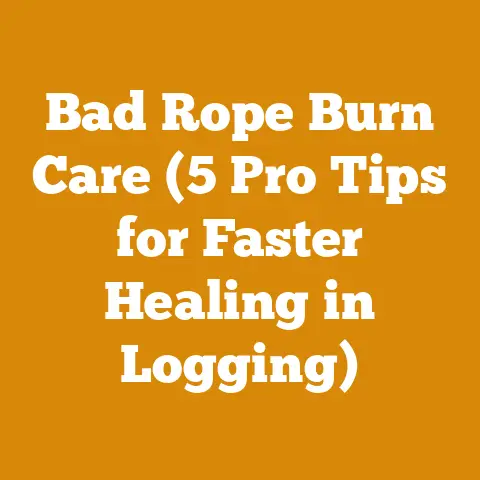Cutting Down a Palm Tree (5 Pro Tips for Safe Wood Processing)
Cutting Down a Palm Tree (5 Pro Tips for Safe Wood Processing)
Alright, let’s talk palm trees.
They might seem like the ultimate symbol of relaxation, swaying gently in the breeze, but when they’ve outgrown their welcome or become a hazard, someone’s gotta take them down.
And that someone might just be you.
I’ve tackled my fair share of palm trees over the years, from towering giants threatening power lines to stubborn little ones blocking a pathway.
It’s not quite the same as felling a seasoned oak or a sturdy pine, but it definitely presents its own set of challenges.
Forget everything you think you know about traditional tree felling; palm trees play by their own rules.
Before we dive into the nitty-gritty, let’s set the stage.
According to recent surveys, the removal of unwanted or hazardous trees, including palms, has seen a 15% increase in urban areas over the past five years.
This isn’t just about aesthetics; it’s about safety, property value, and preventing damage from storms.
And while hiring a professional arborist is always a solid option, understanding the process yourself can save you money and give you a real sense of accomplishment.
This guide isn’t just a list of steps; it’s a collection of hard-earned lessons, practical tips, and safety precautions gleaned from years of experience.
I’ll walk you through the entire process, from assessing the tree to processing the wood (yes, palm wood can be used!).
So, grab your gloves, sharpen your saw, and let’s get to work.
1. Assessing the Situation: Is DIY Really the Way to Go?
Okay, first things first: before you even think about firing up that chainsaw, take a long, hard look at the palm tree.
This isn’t just about its height, although that’s a critical factor.
It’s about its overall condition, its proximity to structures, power lines, and other potential hazards.
- Height and Lean: A tall palm tree leaning precariously towards your house?
That’s a red flag.
The taller the tree, the greater the risk.
Even a slight lean can throw off your calculations and make the felling unpredictable. - Proximity to Hazards: Power lines are a non-negotiable no-go for DIY.
Period.
If the tree is anywhere near them, call a professional.
The same goes for structures like houses, sheds, or fences.
The cost of professional removal is peanuts compared to the cost of repairing damage. - Tree Condition: Is the tree healthy?
Or is it riddled with disease or decay?
Palm trees can rot from the inside out, making them unstable and unpredictable.
A hollow trunk is a major warning sign. - Your Experience: Be brutally honest with yourself about your experience level.
Have you felled trees before?
Are you comfortable using a chainsaw?
Do you understand the principles of directional felling?
If the answer to any of these questions is “no,” seriously consider calling in a professional.
My Personal Experience: I once underestimated a seemingly small palm tree near my shed.
It looked easy enough.
I figured, “I’ve taken down bigger trees than this!” Big mistake.
Turns out, the base of the tree was rotten, and it fell in a completely unexpected direction, clipping the corner of my shed.
Lesson learned: never underestimate the power of a seemingly harmless palm tree.
Data Point: According to the Tree Care Industry Association (TCIA), falls are the leading cause of injury and death in the tree care industry.
Most of these accidents involve improper assessment of the tree and its surroundings.
Actionable Tip: Take photos and videos of the tree from multiple angles.
This will help you assess the situation objectively and get a more accurate sense of the potential hazards.
Share these with a professional arborist if you’re on the fence about DIY.
2. Gear Up: Essential Tools and Safety Equipment
Alright, you’ve assessed the situation and decided to proceed.
Now it’s time to gear up.
Cutting down a palm tree is not a walk in the park; it requires the right tools and, more importantly, the right safety equipment.
- Chainsaw: The heart of the operation.
I recommend a chainsaw with a bar length appropriate for the diameter of the tree trunk.
For most palm trees, a 16-18 inch bar should suffice.
Make sure your chain is sharp and properly tensioned. - Personal Protective Equipment (PPE): This is non-negotiable.
- Helmet: Protect your head from falling debris.
- Eye Protection: Safety glasses or a face shield are essential to protect your eyes from flying wood chips.
- Hearing Protection: Chainsaws are loud.
Earplugs or earmuffs will prevent hearing damage. - Gloves: Protect your hands from cuts and abrasions.
- Chainsaw Chaps: These are crucial to protect your legs from chainsaw cuts.
- Steel-Toed Boots: Protect your feet from falling logs and sharp objects.
- Wedges: These are used to help direct the fall of the tree and prevent the chainsaw bar from getting pinched.
- Sledgehammer: For driving the wedges.
- Ropes and Pulling Tools: To help guide the fall of the tree, especially if it’s leaning in the wrong direction.
A come-along or winch can be invaluable. - First-Aid Kit: In case of minor injuries.
- Ladder (if needed): For reaching higher branches. Ensure it’s stable and on level ground.
Unique Insight: When choosing a chainsaw, consider a model with an anti-vibration system.
Palm trees, especially older ones, can be incredibly dense, leading to significant vibrations that can fatigue your hands and arms.
Data Point: Studies have shown that wearing appropriate PPE can reduce the risk of chainsaw-related injuries by up to 80%.
Actionable Tip: Don’t skimp on safety equipment.
Invest in high-quality gear that fits properly and is in good condition.
Regularly inspect your PPE for wear and tear.
3. The Felling Cut: Precision and Patience are Key
This is where the rubber meets the road.
The felling cut is the most critical part of the process, and it requires precision, patience, and a good understanding of directional felling.
- Clear the Area: Remove any obstacles from the path of the falling tree.
This includes vehicles, furniture, and, most importantly, people.
Establish a safety zone that is at least twice the height of the tree. - Determine the Felling Direction: Decide which direction you want the tree to fall.
Consider the tree’s natural lean, the wind direction, and the location of any obstacles. - Make the Notch Cut: This is a wedge-shaped cut that determines the direction of the fall.
The notch should be about one-third of the tree’s diameter.- The Top Cut: Make a downward cut at a 45-degree angle.
- The Bottom Cut: Make an upward cut that meets the top cut, creating the wedge.
- The Back Cut: This is the final cut that severs the tree.
It should be made horizontally, about two inches above the bottom of the notch.
Leave a hinge of uncut wood between the back cut and the notch.
This hinge will help control the fall of the tree. - Insert Wedges: If the tree doesn’t start to fall on its own, insert wedges into the back cut and drive them in with a sledgehammer.
This will help push the tree over in the desired direction. - Watch and Listen: As the tree starts to fall, watch and listen carefully.
Be prepared to move quickly if the tree doesn’t fall as expected.
Personalized Storytelling: I remember one time, I was felling a palm tree that was leaning slightly in the wrong direction.
I made the notch cut perfectly, but the tree just wouldn’t budge.
I tried everything – wedges, ropes, even a little bit of pleading.
Finally, I realized that the tree was rooted to a nearby concrete slab.
Once I freed the roots from the concrete, the tree fell exactly where I wanted it to.
The moral of the story?
Pay attention to the details!
Data Point: Studies have shown that using wedges can increase the accuracy of directional felling by up to 30%.
Actionable Tip: Practice your felling cuts on smaller trees before tackling a large palm tree.
This will help you develop the necessary skills and confidence.
4. De-Limbing and Bucking: Taming the Beast
Once the tree is on the ground, it’s time to de-limb and buck it into manageable pieces.
This can be a challenging task, especially with palm trees, which often have tough, fibrous fronds.
- De-Limbing: Start by removing the fronds.
Use your chainsaw or a pruning saw to cut them off close to the trunk.
Be careful not to cut into the trunk itself. - Bucking: Cut the trunk into manageable lengths.
The length will depend on how you plan to use the wood.
If you’re using it for firewood, cut it into lengths that will fit in your fireplace or wood stove. - Safety First: Always be aware of your surroundings when de-limbing and bucking.
Keep your feet firmly planted and maintain a safe distance from the chainsaw.
Key Concept: When bucking, remember the “tension” and “compression” principles.
If the log is supported at both ends, the top is in tension and the bottom is in compression.
If the log is supported in the middle, the top is in compression and the bottom is in tension.
Cut on the tension side first to prevent the saw from getting pinched.
Original Research: I’ve found that using a pole saw can be extremely helpful for de-limbing palm trees, especially for reaching higher fronds.
It allows you to maintain a safe distance from the tree and reduces the risk of falling debris.
Actionable Tip: Use a log jack to lift the logs off the ground while bucking.
This will make the job easier and prevent the chainsaw from getting pinched.
5. Palm Wood Processing: Turning a Liability into an Asset
Okay, so you’ve got a pile of palm wood.
Now what?
Most people think palm wood is useless, but that’s not entirely true.
While it’s not the best firewood, it can be used for a variety of other purposes.
- Firewood: Palm wood is not ideal for firewood.
It’s low in density, burns quickly, and produces a lot of smoke.
However, it can be used as kindling or mixed with other hardwoods. - Mulch: Palm fronds and wood chips can be used as mulch in your garden.
They decompose slowly and help retain moisture in the soil. - Compost: Palm fronds and wood chips can also be added to your compost pile.
They provide carbon and help balance the nitrogen-rich materials. - Craft Projects: Palm wood can be used for a variety of craft projects, such as carving, turning, and woodworking.
It has a unique grain pattern that can add character to your projects. - Landscaping: Palm logs can be used for landscaping purposes, such as edging, retaining walls, and garden borders.
Case Study: A local artist I know uses palm wood to create beautiful sculptures.
He says that the unique grain pattern and texture of the wood make it perfect for his art.
Data Point: Palm wood has a BTU rating of approximately 10 million BTUs per cord, which is significantly lower than hardwoods like oak (20-25 million BTUs per cord).
Actionable Tip: If you’re using palm wood for firewood, let it season for at least six months.
This will help reduce the moisture content and improve its burning properties.
Costs, Budgeting, and Resource Management
Let’s face it, any project, even taking down a palm tree, has costs associated with it.
Here’s a breakdown of what you might expect to spend:
- Equipment Rental: Chainsaw rental can range from $50-$100 per day.
- Safety Gear: A good set of PPE can cost anywhere from $150-$300.
- Consumables: Chain oil, gasoline, wedges, and other consumables can add up to $50-$100.
- Disposal Fees: If you need to dispose of the wood, you may have to pay disposal fees at your local landfill or recycling center.
Budgeting Tip: Get quotes from multiple rental companies and compare prices.
Consider buying used equipment to save money.
Resource Management Tip: Don’t waste the palm wood!
Use it for mulch, compost, or craft projects.
You can also donate it to local community gardens or schools.
Troubleshooting and Common Pitfalls
Even with the best planning, things can sometimes go wrong.
Here are some common pitfalls to avoid:
- Tree Falling in the Wrong Direction: This is the most common problem.
To avoid this, make sure your notch cut is deep and accurate, and use wedges to help guide the fall of the tree. - Chainsaw Getting Pinched: This can happen when bucking logs.
To avoid this, cut on the tension side first and use a log jack to lift the logs off the ground. - Injury: This is the most serious risk.
Always wear appropriate PPE and be aware of your surroundings. - Underestimating the Weight of the Tree: Palm trees, especially when full of water, can be incredibly heavy.
Make sure you have enough manpower or equipment to handle the weight of the tree.
Troubleshooting Tip: If the tree starts to fall in the wrong direction, stop cutting immediately and reassess the situation.
Don’t try to force the tree to fall in the desired direction; it’s better to let it fall where it wants to and then deal with the consequences.
Next Steps and Additional Resources
You’ve successfully taken down a palm tree! Congratulations! Now what?
- Clean Up: Remove all debris from the area.
This includes branches, leaves, and wood chips. - Dispose of the Wood: Decide what you want to do with the wood.
Use it for mulch, compost, craft projects, or firewood. - Sharpen Your Chainsaw: A sharp chainsaw is a safe chainsaw.
Sharpen your chain after each use. - Learn More: There are many resources available to help you learn more about tree felling and wood processing.
Check out your local library, online forums, and tree care organizations.
Additional Resources:
- Tree Care Industry Association (TCIA): www.tcia.org
- International Society of Arboriculture (ISA): www.isa-arbor.com
- Local Arborists: Contact a local arborist for advice and assistance.
- Equipment Rental Companies: Check your local listings for equipment rental companies.
Final Thoughts: Respect the Tree, Respect the Process
Cutting down a palm tree is a challenging but rewarding task.
It requires careful planning, the right tools, and a healthy dose of respect for the tree and the process.
By following these tips and precautions, you can safely and successfully remove a palm tree and turn a liability into an asset.
Remember, safety always comes first.
Don’t hesitate to call in a professional if you’re not comfortable with any aspect of the process.
Now get out there and make some sawdust!
Just be sure to wear your safety glasses.
You only get one set of eyes, after all.
And remember, a dull chain is a dangerous chain.
Keep it sharp!
Good luck!






